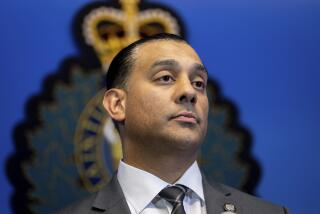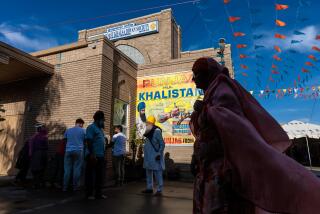Eagle Was Sikh’s Divine Signal of Revenge, Gandhi Assassination Trial Told
- Share via
NEW DELHI — Last August, the prosecutor said, an eagle descended from the heavens and came to rest in a tree not far from where Beant Singh stood guard outside the home of Prime Minister Indira Gandhi.
Singh and others, he went on, took it as a sign from the 10th guru of their Sikh religion that Singh had been divinely chosen to avenge an army raid the prime minister had ordered against the Sikhs’ sacred Golden Temple.
The prosecutor, K.L. Arora, charged that two months after the eagle’s appearance, Singh and another member of the security guard gunned down the prime minister on a flower-lined path outside her residence. Singh was killed in the attack.
Arora laid out the government’s case Thursday in the opening session of the assassination trial. The government said it will present several witnesses who saw Singh and the other guard, Satwant Singh, fire the bullets that killed Indira Gandhi.
(The two men are not related; Singh is a common Sikh name.)
Slugs determined later to have come from Beant Singh’s .38-caliber revolver and Satwant Singh’s submachine gun were removed from the prime minister’s body.
Work Schedules Changed
Arora said the government will show that the two men changed their working schedules so that they would both be on duty outside the prime minister’s bungalow, at No. 1 Safdarjang Road, on the morning of Oct. 31, 1984, when the assassination took place.
But the government is relying on less substantial evidence to prove its case of a wider conspiracy. The defendants are Satwant Singh; Balbir Singh, a Delhi police constable who was also a member of the prime minister’s security staff, and Kehar Singh, a government functionary.
That evidence includes a cryptic diary kept in English by Balbir Singh; a gold bracelet and ring given by Beant Singh to Kehar Singh; reports of a secretive conversation, punctuated by laughter, between Satwant Singh and Balbir Singh in the Punjabi language on the eve of the assassination.
And there is a solemn, confusing pledge by Balbir Singh in front of several witnesses at the Sikhs’ Bangla Sahib Temple in New Delhi that he would “become a Christian” and kill Indira Gandhi for the equivalent of $12,000 and a promise that his children would be taken to the United States.
Defense attorney P.N. Lekhi, who will make his opening argument today, told reporters that the trial can be considered in “Hans Christian Andersen style.”
Just ‘Fairy Tales’
“When fairy tales can be facts, then obviously they have a case,” Lekhi said.
A flamboyant attorney known mostly for his anti-Communist writings, Lekhi is expected to argue that Satwant Singh did not take part in the assassination, that he was shooting at Beant Singh after the attack on the prime minister began.
The trial is taking place in a small, hot room, about 30-by-30 feet. Chief Sessions Judge Mahesh Chandra, in black jacket and striped trousers, presides behind a table on an elevated platform at one side. Only about 40 people are present, mostly attorneys, policemen and reporters.
The three defendants are inside a compartment of bullet-proof glass that measures about 5-by-15 feet and contains a bench and an electric fan.
As it happened, Thursday was the anniversary of the day, a year ago, when the Indian army overwhelmed armed Sikh separatists in the Golden Temple at Amritsar and took over the temple grounds, the holiest site in all Sikhdom. Inside the temple, soldiers found the body of Jarnail Singh Bhindranwale, the militant Sikhs’ leader.
In memory of the assault on the temple and the death of Bhindranwale, militant Sikh leaders have termed this week “Genocide Week.” The anniversary was marked by scattered violence and intense army and police security precautions.
Sikhs in Detention
Last month, Parliament enacted special anti-terrorist laws that give the authorities extraordinary powers. Hundreds of Sikhs have been placed in preventive detention.
Nevertheless, the United News of India agency reported that hundreds of young Sikhs, wearing the saffron-colored turbans that signify the wearer’s willingness to sacrifice his life for the faith, gathered at the Golden Temple to mark the anniversary. Many reportedly carried banners praising the prime minister’s assassins for “enhancing the prestige of the Sikh community.”
Several of the saffron turbans could be seen in the courtroom as prosecutor Arora presented his case. One of the defendants, Kehar Singh, wore a saffron band that showed beneath his blue turban.
More to Read
Sign up for Essential California
The most important California stories and recommendations in your inbox every morning.
You may occasionally receive promotional content from the Los Angeles Times.













